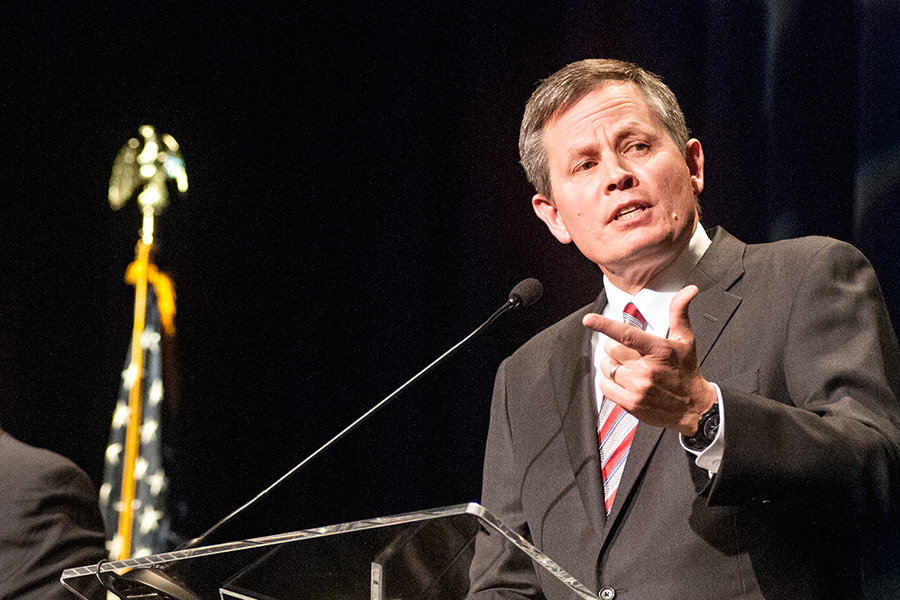The political landscape surrounding Montana’s race for an open U.S. Senate seat has shifted dramatically in the past year, and yet despite its filigree of fault lines and revolving cast of candidates, the projected outcome of the General Election has been defined by stability.
On Nov. 4, sitting Republican Congressman Steve Daines hopes to do what no Republican has accomplished in more than a century by defeating newcomer Amanda Curtis in a race that could help decide which party controls the U.S. Senate.
Not since former governor Joseph Dixon held the seat in 1907 has a Republican sat in the Montana U.S. Senate seat on the ticket this election. But the magnitude of the race’s recent vicissitudes – most notably the decision by incumbent Democrat U.S. Sen. John Walsh to bow out amid plagiarism allegations – means that Daines is poised to make history.
Even when the race was decidedly more cutthroat, Daines was considered a favorite, and most political pundits have declared Montana’s Senate race a safe Republican pickup in November.
It helps that Daines, the state’s lone U.S. Representative, has enjoyed the advantage of statewide name recognition, as well as access to the deep pockets of donors, raising more than $1.8 million for his campaign between July and September with $1.6 million on hand for the final weeks of the race.
Curtis, a 35-year-old math teacher from Butte, is the Democratic nominee to replace Walsh. If she wins, she would be the youngest U.S. senator in Washington, D.C.
In two months, her nascent campaign has raised $500,000, which is evidence of her hustle and energy, but still leaves her trailing by a wide margin.
Libertarian candidate Roger Roots is also on the ballot, though his campaign has not raised enough money to meet the minimum Federal Elections Commission reporting threshold.
Curtis, who is serving her first term in the Montana state house, has experienced a flood of support that is buoying her long-shot campaign, giving Montana Democrats hope. She ran for an open Montana House seat in 2012, easily won the primary and was unchallenged in the general election. She wasn’t planning on running for re-election because redistricting would have put her up against other Butte Democrats.
But when Walsh dropped his re-election bid in the face of evidence that he had plagiarized a paper from the U.S. Army War College in 2007, Daines, rather than facing a quasi-incumbent, squared off against the Democrats’ hand-picked replacement candidate.
Curtis brings a fresh face to the contest, but her left-of-center political views, many of which are broadcast on her YouTube account, have received mixed reactions in right-of-center Montana.
While Montana voters tend to lean Republican at the presidential level, the state and local levels often are characterized by a robust Democratic and progressive streak, and populist Democrats like former Gov. Brian Schweitzer have enjoyed popularity. Former Sen. Conrad Burns is the only Republican to ever be elected to successive terms in Montana.
U.S. Sen. Max Baucus was elected to the House in 1974 and four years later, following the death of Sen. Lee Metcalf, he defeated appointed Sen. Paul Hatfield in the Democratic primary before going on to win the general election by almost a dozen points.
When Baucus announced his retirement last year, most observers expected Schweitzer to replace him, but when the former governor announced his decision not to run, Montana Democrats’ chances of claiming the seat declined and the party was left with a political vacuum to fill.
The void seemed less expansive when Baucus was appointed ambassador to China, allowing Gov. Steve Bullock to appoint Walsh, his lieutenant governor, to the seat.
The appointment gave Walsh status as an incumbent, giving him 10 months in office before voters cast a ballot. Still, it wasn’t clear whether the incumbency would serve as an advantage or a handicap, and the heightened scrutiny unearthed skeletons from Walsh’s recent past.
U.S. Sen. Jon Tester said recently that he expected Walsh would have won if not for the plagiarism scandal, which overwhelmed the Walsh campaign when The New York Times revealed the allegations in July.
David Parker, an associate professor of political science at Montana State University, cited data showing that only about 43 percent of appointed senators who run for their seat win their elections, compared to 85 percent of incumbents.
In a guest blog post for the Washington Post, Parker and University of Montana associate professor of political science Robert Saldin, opined that there are several reasons that Republicans are still favored to win the seat.
The professors point to a national political climate that will likely favor Republicans this election cycle, in which Democrats’ popularity has plunged under the millstone of the Affordable Care Act, or Obamacare, as well as the advantages Daines has cultivated since he entered the campaign.
As Montana’s lone sitting Congressman, he has become popular among moderates and Tea Party conservatives alike.
Curtis, who was selected by state Democrats at a special convention Aug. 16 – 80 days before the General Election – has fashioned herself as a candidate who will represent working class families rather than those of the wealthy. She has also said she is not cowed by the odds of her campaign, and promised to pursue the seat aggressively.
